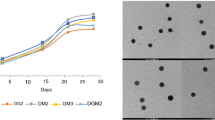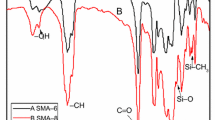Abstract
The potentiometric titration of carboxylated methyl methacrylate latexes prepared with varying amounts of methacrylic acid showed that only very small amounts of their total acids copolymerized were neutralized at room temperature until the acid level was well above 10%. However, it was found that all the acids copolymerized were completely titrated either in a 50/50 water/ethanol mixture at room temperature or in water at high temperatures near their backbone polymer T gs, regardless of their acid contents, as predicted from the existing theories on the alkali-swelling of carboxylated latexes. It was also found that these high-temperature alkali-swollen latex particles remained in the swollen state even after they were cooled down to room temperature and became film-forming at much lower temperatures. This discovery led to a new technology coined as a high-temperature water-extended latex technology. This new technology enabled us to develop VOC-free water-extended latexes of high-T g polymers that would exhibit good film formation at ambient temperature and turn into hard and non-blocking latex films and latex-bound pigmented coatings upon drying. Particularly, when fugitive bases were used for neutralization at high temperatures, the resulting water-extended latexes became hard, non-blocking, and water-resistant binders upon drying.




Similar content being viewed by others
References
Fordyce DB, Dupre J, Toy W (1959) Alkali Soluble Acrylic Emulsions. Official Digest 31:284
Muroi SJ, Hosoi K, Ishikawa T (1967) Alkali Solubility of Carboxylated Polymer Emulsions Appl. Polym. Sci. 11:1963
Verbrugge CJ (1970) Mechanism of Alkali Thickening of Acid Containing Emulsion Polymers. J. Appl. Polym. Sci. 14:897
Nishida S, El-Aasser MS, Klein A, Vanderhoff JW (1981) Preparation and Characterization of Alkali-Swellable Carboxylated Latexes. In: Bassett DR, Hamilec AE (eds.), Emulsion Polymers and Emulsion Polymerization. ACS Symposium Series 165, ACS, Washington, DC pp 291–314
Lee, DI, “High-Temperature Water-Extended Latex Technology.” 74th Colloid and Surface Science Symposium sponsored by ACS Division of Colloid and Surface Chemistry, Lehigh University, June 19–21 (2000)
Eckersley ST, Rudin A (1990) Mechanism of Film Formation from Polymer Latexes. J. Coat. Technol. 62:89
Sperry PR, Snyder BS, O’Dowd ML, Lesko PM (1994) Role of Water in Particle Deformation and Compaction in Latex Film Formation. Langmuir 10:2619
Scatena, M, Sanmartin, P, Zilio-Grandi, F, “The Effect of Water on the T g of a Bulk-Prepared Poly(Vinyl Acetate).” Proceedings of the IXth FATIPEC Congress, Brussels, Sec. 3, 68 (1968)
Heymans DMC, Daniel MF (1995) Glass Transition and Film Formation of VeoVa/Vinyl Acetate Latices; Role of Water and Co-Solvents. Polym. Adv. Technol. 6:291
Lee, DI, Walker, LC, Kan CS (1997) The Thermal Behaviors of Latexes: Wet Latex Glass Transition Temperatures. Macromol. Symp. 118:267
Kan CS (1999) Role of Particle Size on Latex Deformation during Film Formation. J. Coat. Technol. 71(896):89
Einstein A (1906) Eine neue Bestimmung der Molekueldimensionen. Ann. Phys. 324:289
Einstein A (1911) Berichtigung zu meiner Arbeit: Eine neue Bestimmung der Molekueldimensionen. Ann. Phys. 339:591
Small H, Saunders FL, Solc J (1976) Hydrodynamic Chromatography – A New Approach to Particle Size Analysis. Adv. Colloid Interface Sci. 6:237
Lee DI (2005) The Effects of Latex Coalescence and Interfacial Crosslinking on the Mechanical Properties of Latex Films. Polymer 46 (4):1287
Lee DI (2006) Nanostructured Latexes Made by a Sequential Multistage Emulsion Polymerization. J. Polym. Sci., Part A. Polym. Chem. 44:2826
Acknowledgments
The authors would like to thank their former Dow colleagues, Mike Mulders, Laurie Scott, Karen Klein, and Ralph Czerepinski, for their invaluable contributions to this work. They would also like to express their sincere gratitude to Emulsion Polymers R&D, The Dow Chemical Company, for its support.
Author information
Authors and Affiliations
Corresponding author
Rights and permissions
About this article
Cite this article
Lee, D.I., Chen, F.B. Development of VOC-free, high-T g latex binders by a high-temperature water-extended latex technology. J Coat Technol Res 4, 161–165 (2007). https://doi.org/10.1007/s11998-007-9016-1
Published:
Issue Date:
DOI: https://doi.org/10.1007/s11998-007-9016-1




